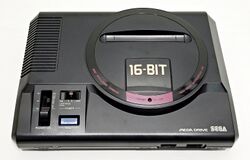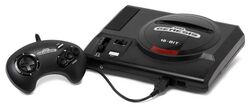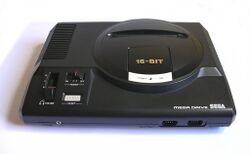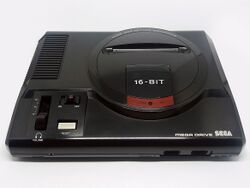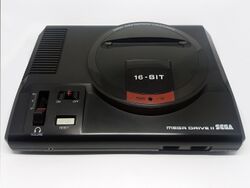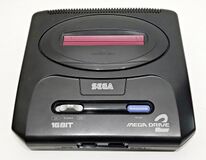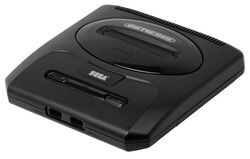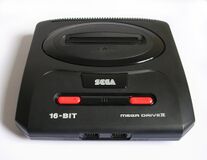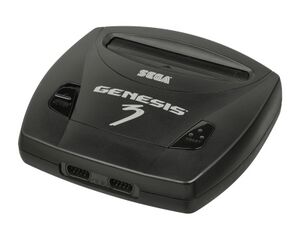Difference between revisions of "Sega Mega Drive"
From Sega Retro
(→Notes) |
|||
| Line 395: | Line 395: | ||
MegaDrive AS logo.png|Asian logo | MegaDrive AS logo.png|Asian logo | ||
</gallery> | </gallery> | ||
| − | |||
| − | |||
| − | |||
| − | |||
| − | |||
==References== | ==References== | ||
Revision as of 16:14, 20 December 2017
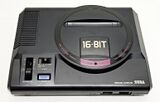 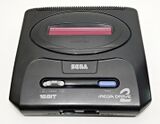
| ||||||||||||||||||||||||||||||||||||||||||||||||||||||||||||||||||||||||||||||||||||||||||||||||||||
| Sega Mega Drive | ||||||||||||||||||||||||||||||||||||||||||||||||||||||||||||||||||||||||||||||||||||||||||||||||||||
|---|---|---|---|---|---|---|---|---|---|---|---|---|---|---|---|---|---|---|---|---|---|---|---|---|---|---|---|---|---|---|---|---|---|---|---|---|---|---|---|---|---|---|---|---|---|---|---|---|---|---|---|---|---|---|---|---|---|---|---|---|---|---|---|---|---|---|---|---|---|---|---|---|---|---|---|---|---|---|---|---|---|---|---|---|---|---|---|---|---|---|---|---|---|---|---|---|---|---|---|---|
| Manufacturer: Sega | ||||||||||||||||||||||||||||||||||||||||||||||||||||||||||||||||||||||||||||||||||||||||||||||||||||
| Variants: Mega Drive 2, Genesis 3, Mega Jet, Nomad, Mega Tech, Mega Play, Amstrad Mega PC | ||||||||||||||||||||||||||||||||||||||||||||||||||||||||||||||||||||||||||||||||||||||||||||||||||||
| Add-ons: Sega Mega-CD, Sega 32X, Mega Modem, Power Base Converter | ||||||||||||||||||||||||||||||||||||||||||||||||||||||||||||||||||||||||||||||||||||||||||||||||||||
|
The Sega Mega Drive (メガドライブ), called the Sega Genesis in North America and Super Gam*Boy (수퍼겜보이) (later Super Aladdin Boy (수퍼알라딘 보이) in South Korea, is a cartridge-based video game console developed by Sega in 1988.
The Mega Drive is Sega's third home console, following the SG-1000 (including SG-1000 II) and the Sega Master System (Mark III). It was codenamed the Sega Mark V during development and is part of what is now known as the fourth generation of video game consoles.
The Mega Drive is Sega's most successful video game console, selling over 40 million units worldwide,[4] including more than 20 million in the United States, over 9 million in Western Europe, 3.58 million in Japan, and 3 million in Brazil.[5]
It has a software library consisting of more than one thousand games released for the system in total. As well as competing with Nintendo's Famicom (NES) and later Super Famicom (Super NES) for market control, Sega also found itself fighting against NEC's TurboGrafx-16 (PC Engine in Japan), SNK's Neo Geo, the Atari Jaguar and numerous home computers in one of the biggest "console wars" of all time.
It had a cartridge enhancement chip, the Sega Virtua Processor (SVP), and two add-on consoles, the Sega CD and 32X. The Mega Drive would be succeeded by the Sega Saturn (released in 1994), and then the Sega Dreamcast (released in 1998).
Contents
- 1 Hardware
- 1.1 Models
- 1.1.1 Mega Drive
- 1.1.2 Mega Drive 2
- 1.1.3 Genesis 3
- 1.1.4 Portables: Mega Jet and Nomad
- 1.1.5 Arcade hardware: Mega Tech, Mega Play, and the System C
- 1.1.6 Mega-CD combos: JVC Wondermega/X'eye, Pioneer LaserActive, Sega Multi-Mega, and Aiwa Mega CD
- 1.1.7 Computer combinations: Sega Teradrive, Amstrad Mega PC, al-Alamiah units
- 1.1.8 Modern System-on-a-Chip compilations
- 1.2 Cartridges
- 1.3 Technical specifications
- 1.4 Comparison
- 1.1 Models
- 2 History
- 3 Games
- 4 Magazine articles
- 5 Promotional material
- 6 Artwork
- 7 References
Hardware
The Mega Drive was envisioned at the next technological step over other video game consoles available at the time. It is a "16-bit" machine, named after its use of a 16-bit CPU (in this case, the Motorola 68000), and was marketed as being superior to popular "8-bit" consoles dominating the market at the time, usually the Nintendo Entertainment System (NES) but sometimes its immediate predecessor, the Sega Master System. 16-bit CPUs had been gaining popularity since the mid-80s, were widely used in arcade machines, and were almost expected to be found in new home computers - it was therefore considered logical that the next "generation" of dedicated video game consoles should follow suit.
The Mega Drive builds on technology found in the Master System (and with adaptors, is fully backwards compatible), though as well as upping the technical specifications for more demanding gameplay, sound and graphics, makes a number of crucial changes to the design of consoles which continue to this day. Firstly it added a third face button, ![]() , to the (now ergonomically designed) control pad. The Mega Drive outputs sound in stereo, and makes an attempt to region lock games through software. Also, when utilising the right cables, the Mega Drive is natively able to produce a clearer image than its rivals (on top of its already higher resolution 320x240 display).
, to the (now ergonomically designed) control pad. The Mega Drive outputs sound in stereo, and makes an attempt to region lock games through software. Also, when utilising the right cables, the Mega Drive is natively able to produce a clearer image than its rivals (on top of its already higher resolution 320x240 display).
All Mega Drives ultilise a top-loading design (as opposed to the cumbersome VCR-style cartridge loading of the Western NES), while having removable controllers (unlike the Famicom). It was designed from day one to allow hardware expansions, and its use of dark plastic means that the "yellowing" of older systems (from bromine-based flame retardants reacting with oxygen) is less of an issue.
Models
- Main article: Mega Drive consoles.
Mega Drive
The original Mega Drive measures 28 cm×21.2 cm×7 cm. The top of the unit is split into two components: a circular emboss with the cartridge slot and a tagline (which was omitted on later versions), and a control panel containing the power and reset buttons and the volume slider for the headphones jack. Audio output through the original model was mono through the A/V port, while the headphone jack was used for stereo sound. A third DE-9 port on the back of the unit provided additional peripheral support, though was removed from later revisions.
Asian, Japanese and South Korean models have a cartridge locking mechanism which prevents cartridges from being removed when the power is on (which is why "Eastern" cartridges, as well as the Sonic & Knuckles cartridge and various others, have a cut-out on their left sides). Later runs included the TradeMark Security System, missing in early builds causing small compatibility issues, despite the feature having been planned early on.
- Sega Mega Drive (pal asia).jpg
Asian model
- Samsungmegadrive.jpg
South Korean model
Mega Drive 2
1993 saw this cost-reduced redesign (known as the Mega Drive II in Europe, and sold simply as "Genesis" in North America without the Sega prefix), at 22 cm×21.2 cm×5.9 cm, being introduced internationally. One of the major revisions from the original model was the removal of the headphones jack in favor of stereo output through a redesigned 9-pin A/V port. American and European models used a momentary switch for power while non-western models used a left-right switch. Furthermore, the audio mixing circuitry was modified, resulting in noticeably different quality audio output — here is a page with audio samples, provided by little-scale.
A common myth is that the Mega Drive 2 lacks a Z80 — the truth is that it lacks a Zilog Z80. During the Mega Drive's lifetime, Sega received various off-the-shelf chips from different manufacturers, and sometimes would rebrand chips as their own or make them themselves, which is what happened here (and which is why each Mega Drive has a different manufacturer for its 68000). If the Z80 was missing, most games would have no sound (or not all sound). In later revisions, the Z80 was integrated into a custom ASIC which also incorporated the major chips of the system.
The very last revisions of the Mega Drive 2 (post-1996) took a number of cost-saving measures, combining chips and simplifiyng circuitry, but in the process removing support for the Power Base Converter, Mega-CD, 32X and Virtua Racing. The removable expansion cover and Mega-CD connector still exist on these boards, but now advise users not to remove the protective pin cover.
- Super Aladdin Boy II.jpg
South Korean model
Genesis 3
- Main article: Genesis 3.
The Genesis 3 was a small version manufactured by Majesco in 1998 for the American market, which they had been manufacturing for until then. It is much smaller than its predecessors and lacks all expansions and fixes memory controller bugs — both rendering some games unplayable and the Sega CD and 32X unusable.
Portables: Mega Jet and Nomad
- Main articles: Sega Mega Jet and Sega Nomad.
The Mega Jet and Nomad were portable Mega Drive systems released near the middle/end of the system's lifetime. The Mega Jet, released in 1994, was originally designed for use on JAL airliners but was later released for Japanese consumers. The Mega Jet is a semi-portable system; the system has a built-in controller but requires an external power supply and a TV. The Nomad was a full portable in its own right, having an integrated screen and sound capabilities, in addition to a battery pack.
Arcade hardware: Mega Tech, Mega Play, and the System C
The Mega Drive hardware was adapted for arcade use several times over the course of its life. The Mega Tech and Mega Play allowed arcade operators to provide somewhat modified versions of popular Mega Drive games for arcade play — these systems use special cartridges containing games and players can choose from the games plugged into the system. The System C is a different board built from modified Mega Drive hardware, boasting improved color abilities and (in later revisions known collectively as the System C2) improved sample playback. The System C was primarily home to puzzle games — Columns and Puyo Puyo were released on this hardware.
Data East is also known to have licensed Mega Drive hardware for an arcade version of High Seas Havoc; not much is known about this board.
Mega-CD combos: JVC Wondermega/X'eye, Pioneer LaserActive, Sega Multi-Mega, and Aiwa Mega CD
- Main articles: Wondermega, LaserActive, Sega Multi-Mega, Aiwa Mega CD.
Combination Mega Drive/Mega-CD units were developed over the course of the Mega-CD's lifetime. The Wondermega and LaserActive are standalone consoles; the LaserActive also plays LaserDiscs. The Multi-Mega is a portable audio CD player that can play Mega Drive and Mega-CD games when plugged in to wall power and a TV. The Aiwa Mega CD is a Mega Drive/Mega-CD packed into Aiwa's consumer-level portable CD stereos.
Computer combinations: Sega Teradrive, Amstrad Mega PC, al-Alamiah units
- Main articles: Sega Teradrive, Amstrad Mega PC, Al-Alamiah AX-660, Al-Alamiah AX-990.
The Teradrive and Mega PC are combination Mega Drive/IBM-compatible PCs made for the Japanese and UK markets, respectively. The three Al-Alamiah computers are combination Mega Drive/MSX computers for the Arabic market.
Modern System-on-a-Chip compilations
A variety of companies now make licensed system-on-a-chip units in a variety of fashions that contain single-chip Mega Drive implementations and several licensed ROM images. TecToy-made SoaCs also contain several "new" MD games, however these are believed to be — and likely are — Java 2 Mobile Edition games running on additional hardware. For a full list of SoaCs, see the template at the bottom of the page.
Cartridges
- Main article: Sega Mega Drive cartridges.
Technical specifications
- Main article: Sega Mega Drive/Technical specifications.
Comparison
- Main article: Blast processing
It was the most powerful console at the time of its release in 1988, surpassing the PC Engine (TurboGrafx-16), and it was not surpassed in power until the Neo Geo in 1990. The Mega Drive is also more powerful than the SNES, released in 1990, whereas the SNES has a larger color palette (see Blast Processing article for detailed technical comparison between the Mega Drive and SNES).
Compared to home computers at the time, it was not as powerful as the Japan-exclusive Sharp X68000 (released 1987) or FM Towns (released 1989). However, the Mega Drive was more powerful than Western home computers in the late '80s, including the Amiga. The Mega Drive's 68000 CPU is clocked at 7.6 MHz, while the Amiga's 68000 CPU is clocked at 7.16 MHz (NTSC) or 7.09 MHz (PAL). The Mega Drive displays eighty 15-color sprites at 32×32 pixels each, while the Amiga displays eight 3-color sprites at 8 pixels wide.[6] The Mega Drive displays 61–64 colors standard and 114–192 colors with Shadow/Highlight, while the Amiga displays 2–32 colors standard and 64 colors with EHB. The Mega Drive's VDP can DMA blit 3.21845–6.4 MB/s bandwidth (6.4 MPixels/s fillrate), while the Amiga's Blitter can blit 1.7725–3.58 MB/s (2.363333–4.773333 MPixels/s with 64 colors). During active display, with 64 colors at 60 FPS, the VDP can write 708 KB/s to 2 MB/s (1.4–2 MPixels/s) during 320×224 display, while the Blitter can write 332.5–700 KB/s (443,333–933,333 pixels/s) during 320×200 display.[7] The Mega Drive supports tilemap backgrounds, reducing processing, memory and bandwidth requirements by up to 64 times compared to the Amiga's bitmap backgrounds,[8] giving the Mega Drive an effective tile fillrate of 6–36 MPixels/s (see Blast Processing above). The Mega Drive has a Z80 sound CPU and supports 10 audio channels, while the Amiga lacks a sound CPU and supports 4 audio channels.[6]
History
- Main article: History of the Sega Mega Drive.
Games
- Main article: Sega Mega Drive games.
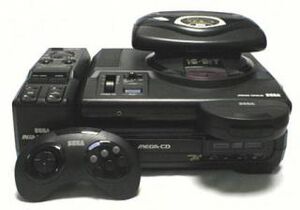
Magazine articles
- Main article: Sega Mega Drive/Magazine articles.
Promotional material
Print advertisements
JP (Sonic the Hedgehog bundle)
- PacksMegaDrive ES PrintAd 1993-06.jpg
ES (8; variation 2)
- 1994 05 - Mega 7.jpg
ES (12)
- 1994 06 - Mega 7.jpg
ES (12; variation)
also published in:
- VideoGames & Computer Entertainment (US) #11: "December 1989" (1989-1x-xx)[11]
- Game Players (US) #0106: "Vol. 1 No. 6 December 1989" (1989-1x-xx)[12]
also published in:
- Computer & Video Games (UK) #107: "October 1990" (1990-09-16)[13]
also published in:
- ACE (UK) #39: "December 1990" (1990-11-xx)[15]
- Computer & Video Games (UK) #109: "December 1990" (1990-11-16)[16]
also published in:
- Computer & Video Games (UK) #114: "May 1991" (1991-04-14)[21]
also published in:
- Hobby Consolas (ES) #8: "Mayo 1992" (1992-0x-xx)[26]
also published in:
- Hobby Consolas (ES) #10: "Julio 1992" (1992-0x-xx)[27]
- Hobby Consolas (ES) #11: "Agosto 1992" (1992-0x-xx)[28]
also published in:
- Hobby Consolas (ES) #13: "Octubre 1992" (1992-xx-xx)[29]
- Mega Force (ES) #5: "Septiembre 1992" (1992-xx-xx)[30]
also published in:
- Mega Force (ES) #6: "Octubre 1992" (1992-xx-xx)[31]
also published in:
- Hobby Consolas (ES) #15: "Diciembre 1992" (1992-xx-xx)[32]
- Hobby Consolas (ES) #16: "Enero 1993" (199x-xx-xx)[33]
- OK Consolas (ES) #12: "xxxx 1992" (1992-xx-xx)[34]
- Micromanía (segunda época) (ES) #56: "Enero 1993" (199x-xx-xx)[35]
- Micromanía (segunda época) (ES) #57: "Febrero 1993" (1993-0x-xx)[36]
also published in:
- Micromanía (segunda época) (ES) #68: "Enero 1994" (199x-xx-xx)[37]
also published in:
- K (IT) #23: "Dicembre 1990" (1990-xx-xx)[38]
- Guida Video Giochi (IT) #16: "Novembre 1990" (1990-1x-xx)[39]
- Guida Video Giochi (IT) #17: "Dicembre 1990" (1990-1x-xx)[40]
also published in:
- Sega Force (SE) #1992-02: "2/92" (1992-11-19)[44]
- Sega Force (SE) #1993-01: "1/93" (1993-01-14)[45]
- Sega Force (SE) #1993-02: "2/93" (1993-03-18)[46]
Retailers
also published in:
- Sega Visions (US) #10: "November/December 1992" (1992-xx-xx)[47]
- Electronic Gaming Monthly (US) #bg93: "1993 Video Game Buyer's Guide" (199x-xx-xx)[48]
- Sega Visions (US) #11: "February/March 1993" (199x-xx-xx)[49]
Pamphlets
Television advertisements
JP (Sonic the Hedgehog bundle)
US ("we bring the arcade experience home")
US ("new generation")
US ("Genesis does sports")
US ("Blast Processing")
UK ("Cyber Razor Cut")
UK ("Cyber Razor Cut" 2)
UK ("Cyber Razor Cut" 4)
UK ("Squeezer")
DE ("Sega TV")
DE (Magnum Set)
NL
AU
KR (Super Gam*Boy)
KR (Super Aladdin Boy)
PT
Artwork
References
- ↑ File:CVG UK 106.pdf, page 13
- ↑ File:ACE UK 37.pdf, page 51
- ↑ 3.0 3.1 File:K IT 22.pdf, page 21
- ↑ Interview: Joe Miller (2013-02-07) by Sega-16
- ↑ Fourth generation of video games
- ↑ 6.0 6.1 What's hot: Amiga or Sega?, Compute!, Issue 125 (January 1991), page A32
- ↑ Blitter Speed (Amiga Hardware Reference Manual)
- ↑ Before the Crash: Early Video Game History, page 173
- ↑ GamePro, "November 1989" (US; 1989-xx-xx), page 52
- ↑ GamePro, "December 1989" (US; 1989-xx-xx), page 22
- ↑ VideoGames & Computer Entertainment, "December 1989" (US; 1989-1x-xx), page 40
- ↑ Game Players, "Vol. 1 No. 6 December 1989" (US; 1989-1x-xx), page 26
- ↑ Computer & Video Games, "October 1990" (UK; 1990-09-16), page 122
- ↑ ACE, "November 1990" (UK; 1990-10-xx), page 36
- ↑ ACE, "December 1990" (UK; 1990-11-xx), page 108
- ↑ Computer & Video Games, "December 1990" (UK; 1990-11-16), page 46
- ↑ Raze, "January 1991" (UK; 1990-11-29), page 64
- ↑ Computer & Video Games, "January 1991" (UK; 1990-12-15), page 86
- ↑ Raze, "February 1991" (UK; 1990-12-20), page 12
- ↑ Raze, "March 1991" (UK; 1991-01-31), page 12
- ↑ Computer & Video Games, "May 1991" (UK; 1991-04-14), page 67
- ↑ Joystick, "Octobre 1990" (FR; 1990-xx-xx), page 86
- ↑ Joystick, "Juillet/Août 1992" (FR; 1992-0x-xx), page 179
- ↑ Joypad, "Juin 1992" (FR; 1992-05-1x), page 83
- ↑ Joypad, "Juin 1992" (FR; 1992-05-1x), page 163
- ↑ Hobby Consolas, "Mayo 1992" (ES; 1992-0x-xx), page 42
- ↑ Hobby Consolas, "Julio 1992" (ES; 1992-0x-xx), page 12
- ↑ Hobby Consolas, "Agosto 1992" (ES; 1992-0x-xx), page 8
- ↑ Hobby Consolas, "Octubre 1992" (ES; 1992-xx-xx), page 14
- ↑ Mega Force, "Septiembre 1992" (ES; 1992-xx-xx), page 22
- ↑ Mega Force, "Octubre 1992" (ES; 1992-xx-xx), page 2
- ↑ Hobby Consolas, "Diciembre 1992" (ES; 1992-xx-xx), page 6
- ↑ Hobby Consolas, "Enero 1993" (ES; 199x-xx-xx), page 6
- ↑ OK Consolas, "xxxx 1992" (ES; 1992-xx-xx), page 6
- ↑ Micromanía (segunda época), "Enero 1993" (ES; 199x-xx-xx), page 32
- ↑ Micromanía (segunda época), "Febrero 1993" (ES; 1993-0x-xx), page 28
- ↑ Micromanía (segunda época), "Enero 1994" (ES; 199x-xx-xx), page 2
- ↑ K, "Dicembre 1990" (IT; 1990-xx-xx), page 2
- ↑ Guida Video Giochi, "Novembre 1990" (IT; 1990-1x-xx), page 15
- ↑ Guida Video Giochi, "Dicembre 1990" (IT; 1990-1x-xx), page 9
- ↑ K, "Febbraio 1991" (IT; 199x-xx-xx), page 15
- ↑ K, "Marzo 1991" (IT; 1991-xx-xx), page 64
- ↑ Bestial!, "xxxx xxxx" (PT; 1993-xx-xx), page 32
- ↑ Sega Force, "2/92" (SE; 1992-11-19), page 36
- ↑ Sega Force, "1/93" (SE; 1993-01-14), page 23
- ↑ Sega Force, "2/93" (SE; 1993-03-18), page 17
- ↑ Sega Visions, "November/December 1992" (US; 1992-xx-xx), page 5
- ↑ Electronic Gaming Monthly, "1993 Video Game Buyer's Guide" (US; 199x-xx-xx), page 51
- ↑ Sega Visions, "February/March 1993" (US; 199x-xx-xx), page 7
| Sega Home Video Game Systems | ||||||||||||||||||||||||||||
| 83 | 84 | 85 | 86 | 87 | 88 | 89 | 90 | 91 | 92 | 93 | 94 | 95 | 96 | 97 | 98 | 99 | 00 | 01 | 02 | 03 | 04 | 05 | 06 | 07 | 08 | 09 | 10 | 11 |
|---|---|---|---|---|---|---|---|---|---|---|---|---|---|---|---|---|---|---|---|---|---|---|---|---|---|---|---|---|
| SG-1000 | SG-1000 II | Mega Drive | Mega Drive II | |||||||||||||||||||||||||
| SC-3000 | Mega-CD | Mega-CD II | Genesis 3 | |||||||||||||||||||||||||
| Sega Mark III | 32X | Dreamcast | ||||||||||||||||||||||||||
| Master System | Master System II | |||||||||||||||||||||||||||
| AI Computer | Game Gear | |||||||||||||||||||||||||||
| Saturn | ||||||||||||||||||||||||||||
| Pico | Beena | |||||||||||||||||||||||||||
- Pages with broken file links
- JP Mega Drive hardware
- US Mega Drive hardware
- DE Mega Drive hardware
- ES Mega Drive hardware
- FR Mega Drive hardware
- NL Mega Drive hardware
- PT Mega Drive hardware
- UK Mega Drive hardware
- SE Mega Drive hardware
- GR Mega Drive hardware
- IT Mega Drive hardware
- AU Mega Drive hardware
- NZ Mega Drive hardware
- MX Mega Drive hardware
- BR Mega Drive hardware
- KR Mega Drive hardware
- TH Mega Drive hardware
- IN Mega Drive hardware
- Mega Drive hardware
- Bad external reference
- GalleryPrintAd file defined
- Sega Mega Drive
